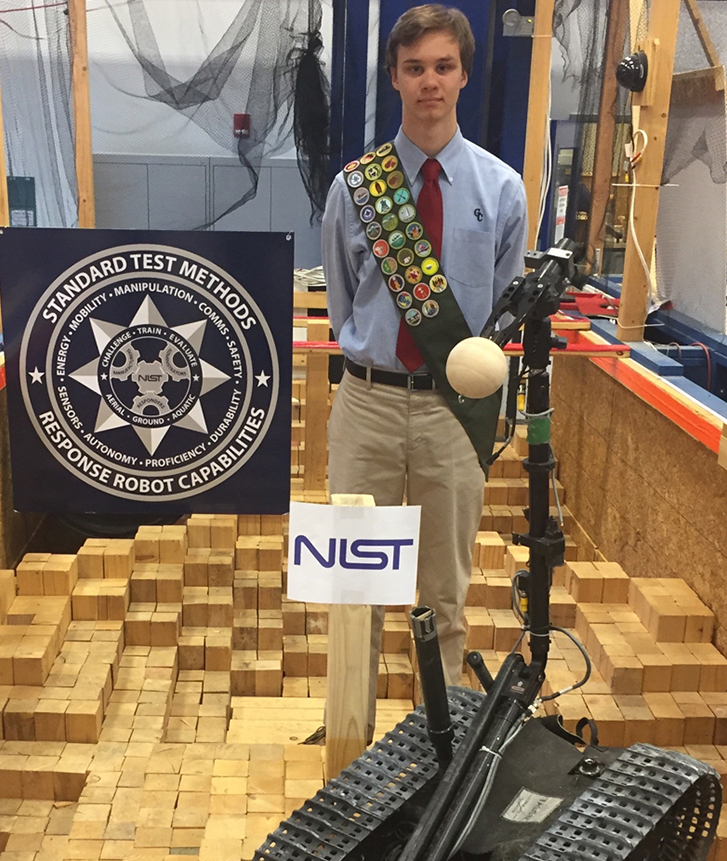
Trustworthy, Loyal...and Inventive
The Boy Scout Law states that a scout display 12 attributes, beginning with “trustworthy” and “loyal” and ending with “clean” and “reverent.” “Inventive” is not among the attributes of the Boy Scout Law, but in the case of Thomas Evers, it certainly could be. Evers, a member of Boy Scout Troop 0463 in Rockville, Maryland (USA), is hoping that his Eagle Scout project, a proposed ASTM standard, will eventually be used to prevent injuries and fatalities caused by land mines.
Evers, 17, is developing an ASTM test method for testing inexpensive and disposable robots that could detect the presence of land mines and/or unexploded ordnance. Evers said his inspiration came from ASTM members Kamel Saidi and Adam Jacoff, both of the U.S. National Institute of Standards and Technology, who collaborated with Raymond Sheh of Curtin University in Australia to create an inexpensive search and rescue robot, known as the Open Academic Robot Kit.
Evers and other members of his high school robotics club had been developing 3D-printed robots based on the Open Academic Robot Kit for a few years, with Saidi and Jacoff working with the club to showcase the robots at events. Tom approached the NIST colleagues with his idea to use 3D printing to create a land mine-detecting robot. This initial request led to the involvement of ASTM Committee E54 on Homeland Security Applications — specifically, Subcommittee E54.08 on Operational Equipment — in Evers’ project. E54 is managed by ASTM staff member Mary Mikolajewski.
“E54.08 is the catalyst for students like me to create the next generation of robots and the next generation of tests,” says Evers. “I used the E54.08 test methods to perfect my robots, and now I am working with E54.08 to expand test methods to include detection of land mines and unexploded ordnance.”
Evers has proposed two designs for potential tests. He has been interviewing bomb technicians to learn what land mine-detecting robots need to do and is preparing to incorporate what he has learned into a revised, more comprehensive draft of the standard. Evers hopes that by early December, he will have completed the test and forwarded it to robot companies and builders for them to assess the test method as a proof of concept.
Saidi notes that Tom’s standard, once approved and adopted by E54 through ASTM’s consensus process, will help users of land mine/unexploded ordnance-capable robots to define realistic requirements before purchasing a robot, and to compare different robots that meet their requirements. The tests in the standard will also help developers improve their robots by highlighting design weaknesses and by communicating to them users’ requirements in the form of tasks to accomplish within the tests.
“I have worked with many students during my career in robotics, and it is always a pleasure to come across students who are as motivated as Tom, and who have the full support of their parents in their endeavors,” says Saidi. “Tom’s Eagle Scout project is a great way to contribute to the community in a much more broadly impactful way.”
For all of its challenges, Evers is happy with the Eagle Scout project he has chosen. “I just want to make a difference, and great mentors like Adam Jacoff and Kamel Saidi, as well as Ann Virts, their colleague at NIST, have given me the opportunity to make it happen,” says Evers. “This project requires a great deal of hard work, is crazy fun, and pretty cool because it will save lives.”
 SN Home
SN Home Archive
Archive Advertisers
Advertisers Masthead
Masthead RateCard
RateCard Subscribe
Subscribe Email Editor
Email Editor